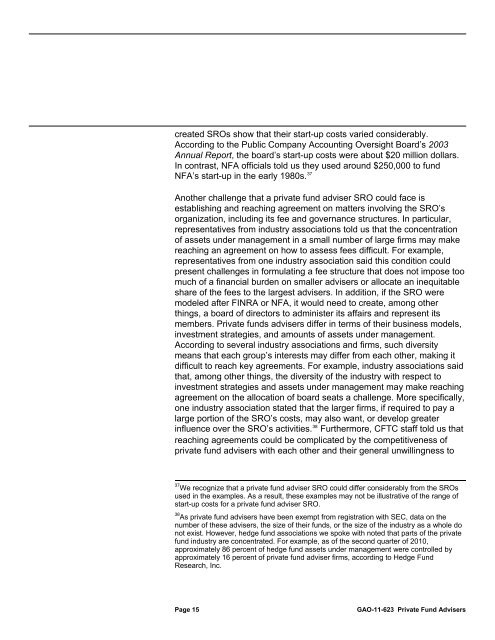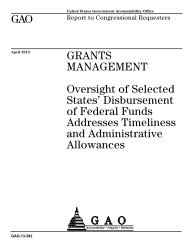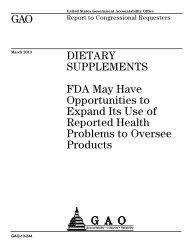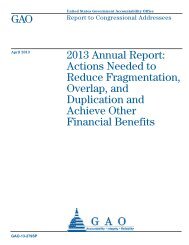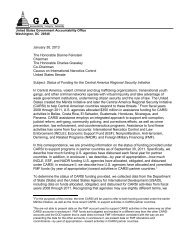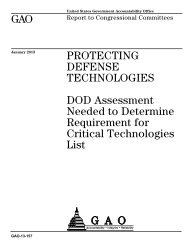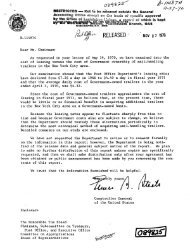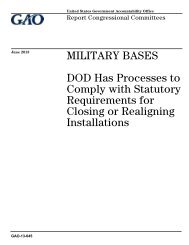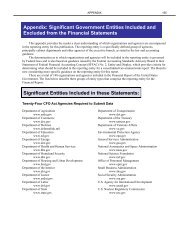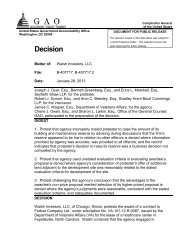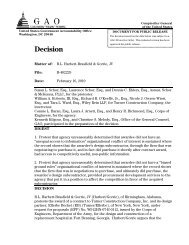GAO-11-623 Private Fund Advisers: Although a Self-Regulatory ...
GAO-11-623 Private Fund Advisers: Although a Self-Regulatory ...
GAO-11-623 Private Fund Advisers: Although a Self-Regulatory ...
You also want an ePaper? Increase the reach of your titles
YUMPU automatically turns print PDFs into web optimized ePapers that Google loves.
created SROs show that their start-up costs varied considerably.<br />
According to the Public Company Accounting Oversight Board’s 2003<br />
Annual Report, the board’s start-up costs were about $20 million dollars.<br />
In contrast, NFA officials told us they used around $250,000 to fund<br />
NFA’s start-up in the early 1980s. 37<br />
Another challenge that a private fund adviser SRO could face is<br />
establishing and reaching agreement on matters involving the SRO’s<br />
organization, including its fee and governance structures. In particular,<br />
representatives from industry associations told us that the concentration<br />
of assets under management in a small number of large firms may make<br />
reaching an agreement on how to assess fees difficult. For example,<br />
representatives from one industry association said this condition could<br />
present challenges in formulating a fee structure that does not impose too<br />
much of a financial burden on smaller advisers or allocate an inequitable<br />
share of the fees to the largest advisers. In addition, if the SRO were<br />
modeled after FINRA or NFA, it would need to create, among other<br />
things, a board of directors to administer its affairs and represent its<br />
members. <strong>Private</strong> funds advisers differ in terms of their business models,<br />
investment strategies, and amounts of assets under management.<br />
According to several industry associations and firms, such diversity<br />
means that each group’s interests may differ from each other, making it<br />
difficult to reach key agreements. For example, industry associations said<br />
that, among other things, the diversity of the industry with respect to<br />
investment strategies and assets under management may make reaching<br />
agreement on the allocation of board seats a challenge. More specifically,<br />
one industry association stated that the larger firms, if required to pay a<br />
large portion of the SRO’s costs, may also want, or develop greater<br />
influence over the SRO’s activities. 38 Furthermore, CFTC staff told us that<br />
reaching agreements could be complicated by the competitiveness of<br />
private fund advisers with each other and their general unwillingness to<br />
37<br />
We recognize that a private fund adviser SRO could differ considerably from the SROs<br />
used in the examples. As a result, these examples may not be illustrative of the range of<br />
start-up costs for a private fund adviser SRO.<br />
38<br />
As private fund advisers have been exempt from registration with SEC, data on the<br />
number of these advisers, the size of their funds, or the size of the industry as a whole do<br />
not exist. However, hedge fund associations we spoke with noted that parts of the private<br />
fund industry are concentrated. For example, as of the second quarter of 2010,<br />
approximately 86 percent of hedge fund assets under management were controlled by<br />
approximately 16 percent of private fund adviser firms, according to Hedge <strong>Fund</strong><br />
Research, Inc.<br />
Page 15<br />
<strong>GAO</strong>-<strong>11</strong>-<strong>623</strong> <strong>Private</strong> <strong>Fund</strong> <strong>Advisers</strong>


